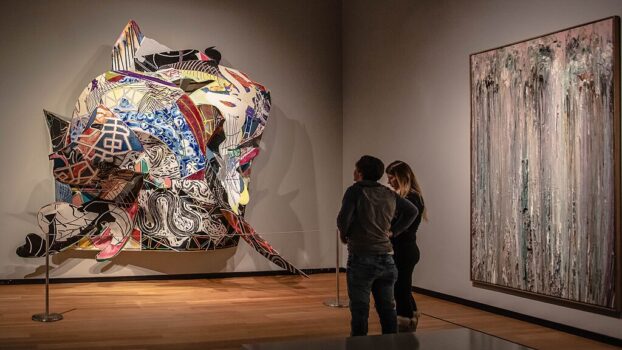What Was Frank Stella Known For
In the vast expanse of 20th and 21st-century art, few names shine with the multifaceted brilliance of Frank Stella. Revered as a trailblazer in the evolution of abstraction, Stella’s work transcends the traditional confines of painting and sculpture. His art doesn’t merely sit on a canvas, it erupts, curves, spirals, and sings in form and color. Whether you’re an art historian, a casual museumgoer, or a passionate collector, encountering Frank Stella’s work is a visceral experience, one that forces you to question what painting can be.
Who is Frank Stella?
Born in 1936 in Malden, Massachusetts, Frank Stella is one of America’s most celebrated artists, often credited with bridging the transition from Abstract Expressionism to Minimalism and Post-Painterly Abstraction. After graduating from Princeton University in 1958, where he studied history, Stella quickly entered the New York art scene with an unexpected bang. At just 23, his now-iconic “Black Paintings” were shown at the Museum of Modern Art in New York.
With his early works, Stella famously declared, “What you see is what you see,” signaling a shift from the emotional and gestural painting of Abstract Expressionists like Jackson Pollock and Willem de Kooning to a more rational, minimal aesthetic.
But Stella wouldn’t be pigeonholed. Over the next six decades, his career became a symphony of invention, one that constantly defied expectations and expanded the very definition of art.
What Was Frank Stella Known For?
Frank Stella is best known for his groundbreaking contributions to Minimalism in the late 1950s and early 1960s and his later evolution into maximalist, three-dimensional constructions that blended painting and sculpture.
His earliest fame came from the “Black Paintings,” a series of geometric, symmetrical works that stripped painting down to its barest essentials. These works didn’t represent anything; they simply were. In doing so, they laid the groundwork for the minimalist ethos: a focus on form, repetition, and purity.
But Stella didn’t stop there. By the 1970s and ’80s, he had transformed his art practice into an exuberant, explosive affair. Works from his “Moby Dick” and “Polish Village” series burst off the canvas, combining shaped canvases, aluminum, fiberglass, and dazzling color to create hybrid forms that felt both architectural and painterly.
How Famous Is Frank Stella?
Few living artists enjoy the acclaim, institutional recognition, and influence that Frank Stella has. Over his long and prolific career, Stella’s work has been celebrated by major museums around the world, including:
The Museum of Modern Art (MoMA), New York
The Whitney Museum of American Art
The Tate Modern, London
Centre Pompidou, Paris
He was the youngest artist ever to be granted a full-scale retrospective at MoMA, at the age of just 34 in 1970. Later, in 1987, he became the first living artist to have another retrospective at MoMA.
Stella’s work is not only revered academically and critically; it has become a staple of public art collections and corporate collections around the world. His large-scale sculptures and wall reliefs are displayed in prominent public spaces, and his influence continues to ripple through generations of artists.
In 2009, President Barack Obama awarded him the National Medal of Arts, underscoring his enduring impact on American culture.
How Does Frank Stella Make His Artwork?
The process of making a Frank Stella artwork varies dramatically depending on the era of his career in question. His artistic evolution can be broadly categorized into three phases:
1. Early Minimalist Paintings (Late 1950s – Mid 1960s)
During this phase, Stella used house paint and enamel on canvas, often working with a ruler and masking tape to create precise, parallel lines and geometric forms. These works emphasized flatness and rejected illusionistic space.
2. Shaped Canvases and Color Experimentation (Late 1960s – 1970s)
Here, Stella began experimenting with shaped canvases, cutting and altering the canvas itself to integrate it into the composition. He used metallic paints, fluorescent colors, and began layering colors in mathematically inspired arrangements. He often worked with assistants and mathematical models to execute these complex designs.
3. Three-Dimensional and Sculptural Work (1980s – Present)
In later decades, Stella pushed beyond the traditional canvas entirely. His works became more like low-relief sculptures and eventually full-blown installations. He used materials such as:
Aluminum and steel
Fiberglass
Carbon fiber
Computer-aided design (CAD)
Digital modeling and CNC (computer numerical control) milling
Stella began incorporating technology into his process, using 3D modeling software and engineering techniques to craft intricate compositions that feel as much engineered as they are painted.
In interviews, Stella has stated that much of his recent work begins with digital designs, which are then materialized through industrial manufacturing processes. It’s a complex marriage of hand, machine, and mind.
What Art Style is Frank Stella Associated With?
Frank Stella is associated with multiple art movements throughout his career:
Minimalism – especially in the early “Black Paintings,” Stella’s work exemplifies the movement’s focus on form, repetition, and the elimination of illusion.
Post-Painterly Abstraction – a term coined by critic Clement Greenberg to describe a cleaner, more structured approach to abstraction.
Abstract Expressionism (early influence) – although Stella rejected the emotionalism of this style, he was deeply aware of its language and sought to react against it.
Maximalism – a term often used to describe his later work, which embraces complexity, color, and exuberance.
Neo-Baroque and Constructivism – influences can be seen in the theatricality and spatial manipulation of his later pieces.
What’s most fascinating is how fluidly Stella moved between these genres, continually innovating while maintaining a distinct visual language of his own.
What Materials Does Frank Stella Use?
Stella’s material vocabulary has expanded dramatically over time. Here’s a closer look:
Early Works:
House paint (Benjamin Moore)
Commercial enamel
Canvas
Middle Period:
Shaped wood panels
Metallic paint
Acrylics and fluorescents
Later Works and Sculptures:
Aluminum
Fiberglass
Carbon fiber
Steel
Digital composites and 3D printed elements
UV cured inks and CNC-routed components
Stella’s embrace of industrial materials and technology made him a precursor to today’s digitally-native artists. His ability to manipulate physical space through painting and sculpture places him at the frontier of contemporary art.
What is Frank Stella’s Famous Artwork?
While Stella’s portfolio spans thousands of pieces, several iconic works stand out:
1. Die Fahne Hoch! (1959)
Part of the Black Paintings series, this piece took its title from the Nazi anthem but used the reference provocatively, challenging viewers to grapple with aesthetics, politics, and memory. It is one of the most important works of early Minimalism and now resides at MoMA.
2. Hyena Stomp (1962)
A riot of color and geometric interplay, this work reflects Stella’s interest in jazz and movement, marking his departure from monochromatic rigor.
3. Empress of India (1965)
A shaped canvas that explores color dynamics and architectural form, this work helped redefine the boundaries of two-dimensional art.
4. Protractor Series (1967–1971)
In this series, Stella used arcs, circles, and vibrant colors to explore the relationship between geometry and perception. These works were instrumental in bringing color back into the minimalist conversation.
5. Polish Village Series (1970s)
Inspired by wooden synagogues destroyed during WWII, these constructions combined painting and relief sculpture in poignant, abstract homage to lost culture and architecture.
6. Moby-Dick Series (1980s–1990s)
Stella created 138 works based on Herman Melville’s novel. These pieces incorporate elaborate sculptural elements and dynamic forms, often resembling waves, whales, or shipwrecks in motion.
How Many Artworks Does Frank Stella Have?
It’s estimated that Frank Stella has produced over 2,000 distinct artworks over the span of his six-decade career. This includes paintings, reliefs, prints, drawings, maquettes, and large-scale sculptures. In addition, he has produced hundreds of editions in printmaking, working extensively with master printers to push the limits of etching, lithography, and silkscreen.
Stella’s printmaking, in particular, is considered some of the most innovative of the 20th century. His collaborations with workshops like Tyler Graphics and Gemini G.E.L. resulted in monumental and technically complex print editions.
How Much Does Frank Stella Art Cost?
Frank Stella’s art is highly sought after in the international art market, commanding prices that reflect his stature.
Auction Records:
In 2019, “Point of Pines” (1959) sold at Christie’s for $28 million, setting a record for the artist.
Other works routinely sell in the $1 million to $10 million range, depending on the size, medium, and provenance.
Prints and Works on Paper:
Limited edition prints can range from $10,000 to $500,000+, depending on rarity and condition.
Some screenprints and lithographs are more affordable for emerging collectors, ranging from $5,000 to $20,000.
Sculptures and Installations:
Large-scale sculptures, particularly from the “Moby Dick” and “Scarlatti” series, can sell for $1 million or more.
Stella’s market has remained robust due to a combination of institutional validation, historical importance, and continued relevance. Blue-chip galleries like Marianne Boesky Gallery and Hauser & Wirth have represented or shown his work, further solidifying his place in the canon.
The Enduring Legacy of Frank Stella
Frank Stella is more than a painter. He is an architect of modernity, a mathematician of color, and a sculptor of space. From the solemn austerity of his early black stripes to the kaleidoscopic cacophony of his later three-dimensional works, Stella has never stopped pushing the boundaries of what art can be.
He stands among the pantheon of American art giants not only because of what he achieved early in his career but because of his refusal to stay still. In every era, he reinvented himself, not as a rejection of the past, but as a natural evolution forward.
In his own words: “You can only work for so long before you get tired of what you’re doing. The key is not to repeat yourself.”
Indeed, in Frank Stella’s ever-expanding universe, repetition gives way to reinvention, and the journey is far from over. image/wikimedia




